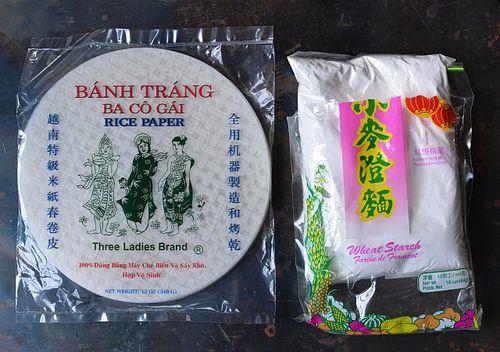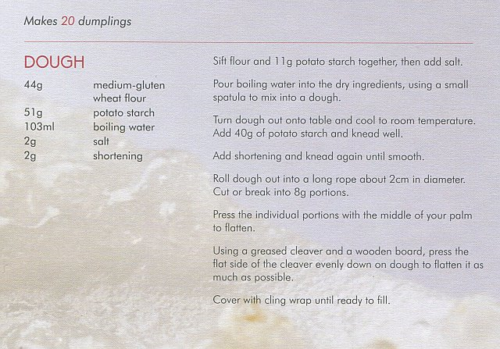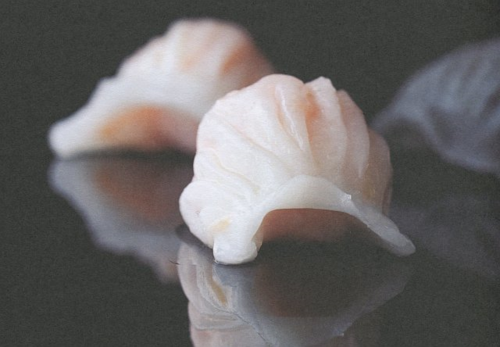Here are two staples that I use for making dumplings and Vietnamese food: wheat starch and rice paper. I employ the former for dim sum such as har gow and the latter for hand rolls or fried cha gio imperial rolls. I suffer allergies but not many food-related ones so I've not thought much about cross-contamination issues in the manufacturing process. Back in February, Mikhaela prompted me to think a little harder about them. I didn't have answers to her questions until today. Even so, I don’t have totally solid answers. Maybe you can help fill in the holes? Here’s her email and what follows is my response:
Dear Andrea,
First, I want to say thank you for your amazing cookbooks and recipes. Your recipes and in-depth tips have allowed me to make food for my food-allergic daughter that she can never eat in a restaurant!
For example--last night I made banh mi using the sandwich recipe from Into the Vietnamese Kitchen, the Vietnamese baguette recipe from your website (we can't buy safe baguettes anywhere because my daughter is allergic to sesame, nuts, mustard, eggs and dairy... your recipe was PERFECT)... and the other night we made char siu bao and potstickers with the recipes from Asian Dumplings.
Anyway, since you always seem to be hunting down ingredients and creating from-scratch recipes, I wonder if you have any thoughts on sourcing or making two items I can't seem to find safe versions of: wheat starch and rice paper sheets? I would love to make some wheat starch dough dumplings and summer rolls that my kid could eat!
I live in Brooklyn, so it is very easy for me to find wheat starch in Chinatown, but I have no idea if it is safe or contaminated with sesame or nuts... And likewise with rice paper sheets. My daughter is so sensitive to cross-contamination that we can't allow her to eat any product that I can't call the manufacturer about and make sure the factory is free from cross-contamination.
Is it possible to make wheat starch as part of the process of making seitan? Most wheat gluten recipes I've seen just discard the water... I'm assuming that's where all the starch and bran end up?
Would the rice sheet recipe in Asian Dumplings work for making Vietnamese summer rolls? Or would I need to do something different?
Making wheat starch from scratch via making seitan. Theoretically, yes you could make seitan from kneading and rinsing a dough of wheat flour and water in lots of water. The starch would release into the water and you’d collect and dry or partially dry the starch to make wheat starch dough. But doesn’t that seem awfully hard and time consuming? How much starch would you get? I don’t know because I have never done it before; I like the convenience of buying the flour at the Chinese market. If you’ve attempted the DIY wheat starch, please share your knowledge!
But maybe a better option is to skip the wheat starch altogether. Today, I came across this unusual recipe for wheat starch dough that employs wheat flour and tapioca starch:
It’s from Dim Sum, a new cookbook published in Asia. Written by two chefs, the book’s recipes are super precise with measurements but unfortunately spotty on technique for the uninitiated. The photos don’t often match the recipe, something that can trip up cooks.
Christopher Tan, a food expert in Singapore, gifted me the book when I visited him in December; we have an ongoing cookbook exchange. Chris and I both noted how the authors, Janice Wong and Ma Jian Jun, opted not to use wheat starch for har-gow dough and the like.
I wished they had explained why they veered away from the conventional practice of combining wheat starch with tapioca or potato starch, just-boiled water and fat, such as oil. Here's a beauty shot of har gow from their book and the dough looks translucent but I am not sure because subsequent shots make the dumplings look opaque.
That said, their wheat starch-less approach may help cooks in situations like Mikhaela. Or, for those who can’t get to an Asian market for wheat starch flour. I’ve not tried out the above recipe so I just scanned it in. Give it a whirl to make the dough and dumplings on pages 132 to 143 in Asian Dumplings.
Subbing fresh rice sheets for rice paper. Mikhaela sounded like a good Viet mom with a potential workaround. A great idea and the result would be like a fresh soft handroll, similar to Hanoi’s pho noodle rolls. But if I were a busy mom, I don’t know how often I could make those fresh rice sheets. At the least, I’d train my kid(s) and go into food production mode.
It’s frustrating that many Asian food producers do not disclose their manufacturing details beyond listing the ingredients. For example, I had to Google kind of deeply to find out that Pearl River Bridge’s Golden Light soy sauce is made with non-GMO soybeans from Canada.
For the rice paper there was nada online so I took a stab at emailing the manufacturer of my go-to brand of rice paper, Three Ladies. About 30 minutes later, I received this email from Tim Chen:
Thank you for your support and promoting our products. We have seen you articles and cookbook and want to say you do an amazing job in promoting Southeast Asian cooking to the mainstream consumers.
We take pride on making the best quality product under the Three Ladies Brand.
Our Three Ladies brand rice paper and rice stick [banh pho] is produced in factories that have very strict quality control. They only produced that specific product. No soy products or nuts of any kind is produced anywhere in the factory.
The products are also non-GMO certified.
So to answer Mikhaela’s question – go ahead and use rice paper (and rice sticks too) by Three Ladies, a brand that’s well distributed at Asian markets in the United States. Hurray! I was proud of myself for solving this issue not just for Mikhaela’s daughter but for any of us who are just plain curious. It’s also nice to know that you can communicate directly with an Asian food producer/distributor. That was totally unexpected.
Know of any other brands of rice paper that is allergen free? Are there brands of pure, gluten-free wheat starch that you’ve heard of?
Note: I've set-up a new commenting system that allows you to upload a photo, vote a comment up or down, etc. Let me know how you like "Disqus." Thanks. I'm still tinkering with it.



















